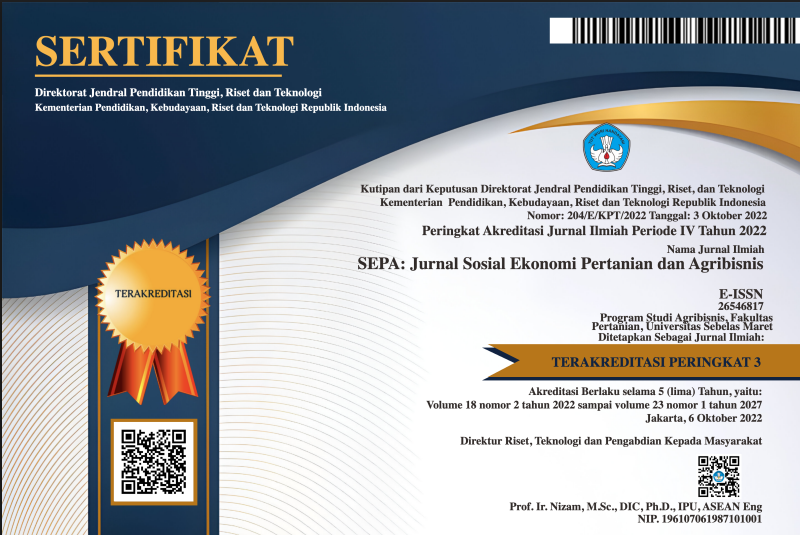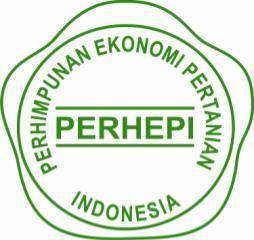MENGGALI POTENSI PEMANFAATAN LAHAN MARGINAL MENJADI LAHAN PRODUKTIF DALAM RANGKA MEMPERTAHANKAN KETERSEDIAAN PANGAN DI MASA MENDATANG
Abstract
Marginal land is a critical land that is less promising. This study aims to identify and analyze the potential of marginal land to anticipate future food availability and to review the constraints faced by marginal land. The methods used is literature study and comparative study. A literature study was conducted to obtain a theoretical basis on the standard of agricultural research centers on marginal lands, while a comparative study was conducted to obtain an overview of agricultural research on marginal lands in Indonesia. The results showed that marginal land had various cultivation potentials such as rice, corn, oil palm, sweet potatoes, and peanuts. The potential of the livestock sector and the tourism sector can also be a potential choice for exploiting the potential of marginal land. The potential for marginal land in the future is expected to be used as a more productive land as an alternative in preparing food availability in the future. So that food and ecosystem stability is maintained. Socio-economic aspects that are considered in the management of marginal land include agro-economy, production, marketing, and institutions. Meanwhile, the constraints on the utilization of marginal land are, among others, prone to high erosion rates, low fertility levels, limited capital, limited facilities and infrastructure, and high rates of crop failure.
Keywords
Full Text:
PDFReferences
Arneth, A., Brown, C., & Rounsevell, M. D. A. (2014). Global models of human decision-making for land-based mitigation and adaptation assessment. In Nature Climate Change (Vol. 4, Issue 7). https://doi.org/10.1038/nclimate2250
Bintang, Supriadi, & Sembiring, M. (2015). Evaluasi Kemampuan Lahan Marginal Desa Sihiong Bonatua Lunasi Tobasa Untuk Tanaman Anggur (Vitis Vinifera L.) Dan Jambu Biji (Psidium guajava L.). Jurnal Pertanian Tropik, 2(2). https://doi.org/10.32734/jpt.v2i2.2898
Bryan, B. A., Nolan, M., McKellar, L., Connor, J. D., Newth, D., Harwood, T., King, D., Navarro, J., Cai, Y., Gao, L., Grundy, M., Graham, P., Ernst, A., Dunstall, S., Stock, F., Brinsmead, T., Harman, I., Grigg, N. J., Battaglia, M., … Hatfield-Dodds, S. (2016). Land-use and sustainability under intersecting global change and domestic policy scenarios: Trajectories for Australia to 2050. Global Environmental Change, 38. https://doi.org/10.1016/j.gloenvcha.2016.03.002
Corbelle-Rico, E., Sánchez-Fernández, P., López-Iglesias, E., Lago-Peñas, S., & Da-Rocha, J. M. (2022). Putting land to work: An evaluation of the economic effects of recultivating abandoned farmland. Land Use Policy, 112. https://doi.org/10.1016/j.landusepol.2021.105808
Damayanti, Y., & Ulma, R. O. (2019). Penentuan Cabang Usahatani Padi, Jagung, Dan Kedelai Yang Optimum Melalui Pola Diversifikasi Dengan Pendekatan Linear Programming Di Kabupaten Muaro Jambi. SEPA: Jurnal Sosial Ekonomi Pertanian Dan Agribisnis, 16(1), 28. https://doi.org/10.20961/sepa.v16i1.30882
Erawanto, Q. D., & Sudaryono, T. (2016). Rehabilitasi Lahan Marginal dalam rangka Meningkatkan Produktifitas dan Konservasi Air. Seminar Nasional Inovasi Tenologi Pertanian, 0341.
Handayani, I. P., & P. P. (2006). Tumbuhan Perintis Pemulih Lahan Kritis Kiat Petani Membangun Kesuburan Tanah.
Idwar, I., Hamzah, A., & Nasrul, B. (2019). Optimalisasi Pemanfaatan Lahan Marginal Kering untuk Budidaya Padi Gogo di Riau. Unri Conference Series: Agriculture and Food Security, 1. https://doi.org/10.31258/unricsagr.1a25
Irawan, B., & Pranadji, T. (2016). Pemberdayaan Lahan Kering untuk Pengembangan Agribisnis Berkelanjutan. Forum Penelitian Agro Ekonomi, 20(2). https://doi.org/10.21082/fae.v20n2.2002.60-76
Kanzler, M., Böhm, C., & Freese, D. (2015). Impact of P fertilisation on the growth performance of black locust (Robinia pseudoacacia L.) in a lignite post-mining area in Germany. Annals of Forest Research, 58(1). https://doi.org/10.15287/afr.2015.303
Khanna, M., Chen, L., Basso, B., Cai, X., Field, J. L., Guan, K., Jiang, C., Lark, T. J., Richard, T. L., Spawn-Lee, S. A., Yang, P., & Zipp, K. Y. (2021). Redefining marginal land for bioenergy crop production. In GCB Bioenergy (Vol. 13, Issue 10). https://doi.org/10.1111/gcbb.12877
Kurnia, U., Sutrisno, N., & Sungkana, I. (2010). Perkembangan Lahan Kritis. Balai Besar Litbang Sumber Daya Lahan Pertanian.
Kurniawan, I. (2010). Optimalisasi Pengelolaan Lahan Marjinal Yang Berkelanjutan Pada Kawasan Pesisir Di Kabupaten Bantul Provinsi D.I. Yogyakarta. In Stpin Diy (Issue 2005).
Malek, Ž., & Verburg, P. H. (2020). Mapping global patterns of land use decision-making. Global Environmental Change, 65. https://doi.org/10.1016/j.gloenvcha.2020.102170
Malkamäki, A., D’Amato, D., Hogarth, N. J., Kanninen, M., Pirard, R., Toppinen, A., & Zhou, W. (2018). A systematic review of the socio-economic impacts of large-scale tree plantations, worldwide. Global Environmental Change, 53. https://doi.org/10.1016/j.gloenvcha.2018.09.001
Marwanto, E. (2018). Optimalisasi Pedididkan dan pelatihan Babinsa Sebagai Motivator dalam Meningkatkan Ketahanan Pangan di Kota Bandung. Comm-Edu (Community Education Journal), 1(2). https://doi.org/10.22460/comm-edu.v1i2.646
Muscat, A., de Olde, E. M., Candel, J. J. L., de Boer, I. J. M., & Ripoll-Bosch, R. (2022). The Promised Land: Contrasting frames of marginal land in the European Union. Land Use Policy, 112. https://doi.org/10.1016/j.landusepol.2021.105860
Nor, D. (2006). Geologi Lingkungan. Graham Ilmu.
Nugroho, H. (2020). Memperkokoh Keterkaitan Ketahanan Pangan, Energi, dan Air (Food-Energy-Water Nexus) Dalam Perencanaan Pembangunan Indonesia. Bappenas Working Papers, 3(2). https://doi.org/10.47266/bwp.v3i2.80
Petani, S. (2018, August 10). Artikel Lahan Marginal Menyimpan Potensi Menunjang KetahananPangan. https://petrokimia-gresik.com/news/lahan-marginal-menyimpan-potensi-menunjang-ketahanan-pangan
Rhofita, E. I. (2022). Optimalisasi Sumber Daya Pertanian Indonesia untuk Mendukung Program Ketahanan Pangan Dan Energi Nasional. Jurnal Ketahanan Nasional, 28(1), 81–99.
Sari, S., Achmar, M., & Zahrosa, D. B. (2020a). Strategi Optimalisasi Penggunaan Lahan Marginal Untuk Pengembangan Komoditas Tanaman Pangan. CERMIN: Jurnal Penelitian, 4(2). https://doi.org/10.36841/cermin_unars.v4i2.771
Sari, S., Achmar, M., & Zahrosa, D. B. (2020b). Strategi Optimalisasi Penggunaan Lahan Marginal Untuk Pengembangan Komoditas Tanaman Pangan. Cermin: Jurnal Penelitian, 4(2). https://doi.org/10.36841/cermin_unars.v4i2.771
Suharta, N. (2010). Karakteristik dan Permasalahan Tanah Marginal dari Batuan Sedimen Masam di Kalimantan. Jurnal Litbang Pertanian, 29(4).
Umulkulsum, D., & Suaji, R. A. D. A. (2020). A new decade for social changes. Technium Social Sciences Journal, 7.
Widyati, E. (2008). Peranan Mikroba Tanah Pada Kegiatan Rehabilitasi Lahan Bekas Tambang. Info Hutan, 5(2).
Witlin, R. (2022). Rising Food Insecurity in 2022. Food Security Update. https://www.worldbank.org/en/research/commodity-markets. https://www.worldbank.org/en/topic/agriculture/brief/food-security-update
Yuwono, N. W. (2009). Membangun kesuburan tanah di lahan marginal. Jurnal Ilmu Tanah Dan Lingkungan, 9(2).
Zimmer, H., Tran, L. D., Dang, T. T., Le, T. H., Lo, Q. T., Minh, D. Lo, & Nichols, J. D. (2022). Rehabilitating forest and marginal land using native species in mountainous northern Vietnam. Trees, Forests and People, 10(August), 100323. https://doi.org/10.1016/j.tfp.2022.100323
DOI: https://doi.org/10.20961/sepa.v21i1.64846
Refbacks
- There are currently no refbacks.



.png)







.png)
3.png)





